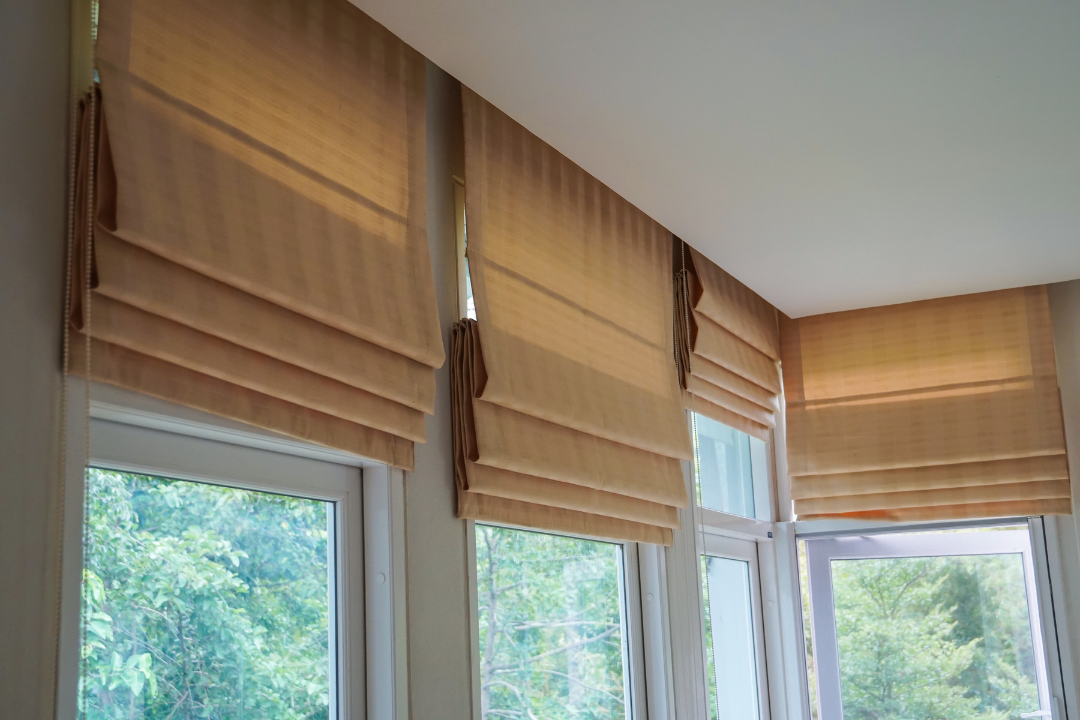What Are Roman Blinds?
Roman blinds are the most elegant of all window coverings. Roman blinds, which are a wonderful compromise between hefty curtains and slim-line roller blinds, provide a comfortable, homely atmosphere in a more compact and versatile form.
Roman blinds are made from mounting slats, cords, and a fabric panel that pleats when raised. The strings pull the slats together when the blind is opened, forcing the cloth into folds. When the cord is released, the slats spring back to their original position. The attractiveness of a Roman blind lies in its ability to be lowered to a specific level so that it always appears attractive while also allowing you privacy and light control.
What Is the Best Location for Roman Blinds?
Roman blinds may be used in many rooms in the house. They’re particularly great for living rooms, which can warm up the design and go with your furniture and soft furnishings. Roman blinds will fit neatly within the recess of smaller living rooms without taking up unnecessary space. For larger areas with huge windows, Roman blinds may be combined with drapes to create a multilayer effect.
Roman blinds are also fantastic for bedrooms, giving it a more warm and more comfortable feel. Your Roman blind can also be finished with a blackout lining to block out all light and create a more restful night’s sleep.
You may put up a Roman blind in your kitchen, but keep in mind where the window is. If you’re going with a fabric that’s wipe-clean and stain-tolerant, avoid using one over a sink or near an eating area.
Which Material Is Best for Roman Blinds?
Roman blinds can be made of a variety of materials, each with its own set of features and properties. The lightest fabrics, such as silk and taffeta, produce smooth folds that glisten in the light. However, if you want to warm up your space or block out all sunshine, these fabrics are not the best option.
Cotton, linen, and synthetic blends are among the lightest fabrics. They come in a wide range of colours and patterns, making it simple to match a Roman blind to your decor. These materials fold into sharp creases when raised; they appear extremely tidy and tidy when folded down.
Finally, roman blinds made of heavy cloth, such as velvet, chenille, and wool, will give a more complete and luxurious appearance. They’re ideal for chilly or drafty rooms since they block the chill while also keeping the space warm and comfortable.
Why Are Roman Shades More Costly?
Roman blinds are often more costly than rollers, verticals, and other kinds of blinds owing to their plush fabric construction. They also need a greater deal of skill and production hours, resulting in a higher price tag. The long-term benefits of high-quality Roman blinds, on the other hand, greatly outweigh the expense, so you can be certain that your new Romans will last a long time and look fantastic.
How Do I Measure for a Roman Blind?
It’s simple to measure for a Roman blind once you’ve measured your windows. All you need is a metal tape measure, a pen or pencil, and some paper to write down your dimensions!
What’s the Best Way to Install a Roman Blind?
To guarantee that your Roman blind performs to its maximum potential, make sure it’s hung and dressed properly. Simply watch our helpful Roman blind fitting video for a step-by-step visual guide. Remember to fold each pleat neatly and check the crease of the lining if your Roman blind has a lining; this can help it fall into position.
How to Clean Roman Blinds?
The cleaning method for Roman blinds is dependent on the fabric, as all textiles have unique cleaning instructions. If you’re unsure, get expert advice so you don’t damage the fabric.
It’s usually simple to keep your Roman blind looking and performing well with some basic light cleaning. Use the soft brush attachment and the lowest setting on your vacuum cleaner to remove dust and dirt. Brush the front of your Roman blind from top to bottom, focusing on the fabric’s edges, which accumulate more dust. Vacuum only the front of your Roman blind; cords can get tangled if you vacuum it back.
Use baby wipes to clean Roman blind chains or strings that are soiled. Clean the mechanism using a basic silicone spray and soft cloth, which will remove dust and prevent squeaking or stiffness.
Stains on Roman blinds are difficult to remove since they’re produced from soft cloth. Fabric stain solvents should be avoided as they can cause discolouration. Baby wipes, which are highly successful at removing stains, may be used instead. If your Roman blind is made of silk or artificial silk, do not attempt to clean it yourself; instead, contact a specialist for assistance.
Fabric rugs, on the other hand, are very absorbent. Fabric rugs are prone to absorbing odours from your home, particularly if they’re located in or near the kitchen. Remove the blind and lay it on a flat surface to release any scents before sprinkling with baking soda. Any odours should have dissipated after 24 hours; vacuum up the baking soda on a low setting after that.
